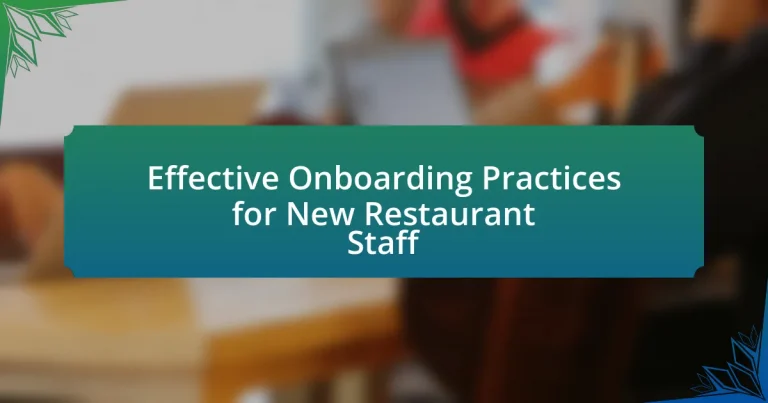Effective onboarding practices for new restaurant staff are essential for enhancing employee retention and performance. Key components of successful onboarding include structured training programs, mentorship, and clear communication of expectations, which collectively contribute to a supportive work environment. Research indicates that effective onboarding can lead to a 25% increase in employee retention rates and improved job satisfaction, ultimately benefiting restaurant operations. The article explores the impact of onboarding on team dynamics, the challenges faced by new hires, and best practices for creating a structured onboarding plan that ensures compliance with health and safety regulations. Additionally, it highlights the importance of mentorship and feedback in refining the onboarding process to foster a cohesive and efficient team.

What are Effective Onboarding Practices for New Restaurant Staff?
Effective onboarding practices for new restaurant staff include structured training programs, mentorship, and clear communication of expectations. Structured training programs ensure that new hires receive comprehensive information about menu items, service standards, and operational procedures, which can lead to a 25% increase in employee retention, as reported by the Society for Human Resource Management. Mentorship pairs new employees with experienced staff, fostering a supportive environment that enhances learning and integration into the team. Additionally, clear communication of expectations helps new hires understand their roles and responsibilities, reducing confusion and improving performance from the outset.
How do effective onboarding practices impact restaurant operations?
Effective onboarding practices significantly enhance restaurant operations by improving employee retention and performance. When new staff members receive structured training and support, they are more likely to feel engaged and competent in their roles, leading to higher job satisfaction. Research indicates that effective onboarding can increase employee retention rates by up to 25%, which reduces turnover costs and maintains service quality. Furthermore, well-onboarded employees tend to perform better, as they understand their responsibilities and the restaurant’s culture, resulting in improved customer service and operational efficiency.
What are the key components of an effective onboarding program?
An effective onboarding program for new restaurant staff includes structured orientation, comprehensive training, mentorship, and ongoing feedback. Structured orientation introduces employees to the restaurant’s culture, policies, and procedures, ensuring they understand their roles and the expectations. Comprehensive training covers essential skills, such as food safety, customer service, and operational procedures, which are critical for performance. Mentorship pairs new hires with experienced staff, providing guidance and support during the initial adjustment period. Ongoing feedback fosters continuous improvement and engagement, helping employees feel valued and connected to the team. These components collectively enhance employee retention and performance, as evidenced by studies showing that effective onboarding can improve retention rates by up to 25%.
How does onboarding influence employee retention in restaurants?
Onboarding significantly influences employee retention in restaurants by enhancing job satisfaction and engagement. Effective onboarding programs provide new employees with essential training, clear expectations, and a sense of belonging, which are critical for their integration into the team. Research indicates that organizations with structured onboarding processes experience 50% greater new hire retention rates compared to those without such programs. This is particularly relevant in the restaurant industry, where high turnover rates can be detrimental to operational efficiency and customer service. By fostering a supportive environment and equipping employees with the necessary skills and knowledge, onboarding directly contributes to lower turnover and higher employee loyalty.
Why is onboarding important for new restaurant staff?
Onboarding is important for new restaurant staff because it enhances employee retention and performance. A structured onboarding process helps new hires understand their roles, the restaurant’s culture, and operational procedures, leading to increased job satisfaction. Research indicates that effective onboarding can improve employee retention rates by up to 25%, as it fosters a sense of belonging and reduces the time it takes for new staff to become productive. Additionally, well-onboarded employees are more likely to provide better customer service, which directly impacts the restaurant’s reputation and profitability.
What challenges do new restaurant staff face during onboarding?
New restaurant staff face several challenges during onboarding, including a steep learning curve regarding menu knowledge, service protocols, and operational procedures. The fast-paced environment of restaurants can overwhelm new employees, making it difficult for them to absorb essential information quickly. Additionally, inconsistent training methods among different staff members can lead to confusion and a lack of clarity about expectations. Research indicates that 70% of employees feel unprepared for their roles due to inadequate onboarding processes, highlighting the need for structured training programs to address these challenges effectively.
How can effective onboarding improve team dynamics?
Effective onboarding improves team dynamics by fostering strong relationships and enhancing communication among team members. When new restaurant staff undergo a structured onboarding process, they gain clarity about their roles, responsibilities, and the overall team culture, which leads to increased collaboration. Research indicates that organizations with effective onboarding programs experience a 50% increase in employee retention and a 60% improvement in team performance, as new hires feel more integrated and supported. This integration reduces misunderstandings and promotes a cohesive work environment, ultimately enhancing team dynamics.

What steps should be included in the onboarding process?
The onboarding process for new restaurant staff should include the following steps: orientation, training, mentorship, and evaluation. Orientation introduces new hires to the restaurant’s culture, policies, and procedures, ensuring they understand the environment they will work in. Training involves teaching specific job skills, such as food preparation, customer service, and safety protocols, which are critical for operational efficiency. Mentorship pairs new employees with experienced staff to provide guidance and support, fostering a sense of belonging and enhancing skill development. Finally, evaluation assesses the new hire’s performance and integration into the team, allowing for feedback and adjustments to the onboarding process as needed. These steps are essential for creating a productive and cohesive work environment in the restaurant industry.
How can restaurants create a structured onboarding plan?
Restaurants can create a structured onboarding plan by developing a comprehensive training program that includes clear objectives, timelines, and resources. This plan should outline specific roles and responsibilities for new hires, incorporate hands-on training with experienced staff, and provide access to essential materials such as employee handbooks and standard operating procedures. Research indicates that structured onboarding can improve employee retention rates by 25% and enhance job satisfaction, as evidenced by a study published in the Journal of Applied Psychology, which highlights the importance of systematic training in reducing turnover.
What training methods are most effective for new restaurant staff?
The most effective training methods for new restaurant staff include hands-on training, mentorship programs, and structured orientation sessions. Hands-on training allows new employees to learn by doing, which has been shown to enhance retention of skills and knowledge. Mentorship programs pair new hires with experienced staff, fostering a supportive learning environment and facilitating knowledge transfer. Structured orientation sessions provide essential information about the restaurant’s policies, culture, and procedures, ensuring that new staff understand their roles and responsibilities from the outset. Research indicates that restaurants implementing these methods experience higher employee satisfaction and lower turnover rates, contributing to a more efficient and cohesive team.
How can restaurants ensure compliance with health and safety regulations during onboarding?
Restaurants can ensure compliance with health and safety regulations during onboarding by implementing a structured training program that covers all relevant guidelines. This program should include comprehensive training sessions on food safety, sanitation practices, and emergency procedures, tailored to meet local health department standards. For instance, the FDA Food Code provides a framework that restaurants can use to develop their training materials, ensuring that staff are well-informed about safe food handling and hygiene practices. Additionally, conducting regular assessments and providing resources such as manuals or online modules can reinforce compliance and keep staff updated on any regulatory changes.
What role does mentorship play in onboarding new staff?
Mentorship plays a crucial role in onboarding new staff by providing guidance, support, and knowledge transfer from experienced employees to newcomers. This relationship helps new hires acclimate to the workplace culture, understand job expectations, and develop necessary skills more efficiently. Research indicates that organizations with structured mentorship programs experience higher retention rates and faster integration of new employees, as mentorship fosters a sense of belonging and enhances job satisfaction. For instance, a study by the Association for Talent Development found that 75% of mentees reported increased confidence in their job performance, demonstrating the effectiveness of mentorship in the onboarding process.
How can pairing new hires with experienced staff enhance the onboarding experience?
Pairing new hires with experienced staff enhances the onboarding experience by providing immediate access to mentorship and practical knowledge. This relationship allows new employees to learn the nuances of their roles more effectively, as experienced staff can offer real-time guidance, answer questions, and share best practices. Research indicates that mentorship can lead to a 20-30% increase in employee retention rates, as new hires feel more supported and integrated into the team. Additionally, this pairing fosters a culture of collaboration and knowledge sharing, which is essential in the fast-paced restaurant environment.
What qualities should mentors possess in a restaurant setting?
Mentors in a restaurant setting should possess strong communication skills, patience, and a deep understanding of the restaurant operations. Effective communication ensures that mentors can clearly convey instructions and feedback to new staff, which is crucial for their development. Patience allows mentors to guide new employees through the learning process, recognizing that skill acquisition takes time. A comprehensive understanding of restaurant operations enables mentors to provide relevant insights and practical knowledge, fostering a supportive learning environment. These qualities contribute to a successful onboarding experience, ultimately enhancing staff performance and retention.

What are the best practices for evaluating onboarding effectiveness?
The best practices for evaluating onboarding effectiveness include setting clear objectives, gathering feedback from new hires, and measuring performance metrics. Establishing specific goals for the onboarding process allows organizations to assess whether new employees are meeting expectations. Collecting feedback through surveys or interviews helps identify areas for improvement and enhances the onboarding experience. Additionally, tracking performance metrics such as employee retention rates and time to productivity provides quantifiable data that reflects the success of the onboarding program. Research indicates that organizations with structured onboarding processes can improve retention rates by 25% and increase employee performance by 11%.
How can restaurants measure the success of their onboarding programs?
Restaurants can measure the success of their onboarding programs through employee retention rates, performance evaluations, and feedback surveys. Employee retention rates indicate how many new hires remain with the restaurant after a specified period, reflecting the effectiveness of the onboarding process. Performance evaluations assess new staff’s job proficiency and integration into the team, providing insights into the training’s impact. Feedback surveys from new employees can reveal their satisfaction with the onboarding experience, highlighting areas for improvement. Collectively, these metrics offer a comprehensive view of onboarding success, enabling restaurants to make data-driven adjustments to enhance their programs.
What metrics should be tracked to assess onboarding effectiveness?
To assess onboarding effectiveness, key metrics include employee retention rates, time to productivity, training completion rates, and employee satisfaction scores. Employee retention rates indicate how many new hires remain with the organization after a specified period, reflecting the onboarding process’s success in integrating staff. Time to productivity measures how long it takes for new employees to reach expected performance levels, highlighting the efficiency of training methods. Training completion rates track the percentage of new hires who finish onboarding programs, ensuring that all necessary skills and knowledge are acquired. Employee satisfaction scores, often gathered through surveys, provide insights into new hires’ experiences during onboarding, helping to identify areas for improvement. These metrics collectively offer a comprehensive view of onboarding effectiveness in the restaurant industry.
How can feedback from new hires improve the onboarding process?
Feedback from new hires can significantly improve the onboarding process by identifying gaps in training and enhancing the overall experience. When new employees share their insights, organizations can pinpoint specific areas where the onboarding materials or procedures may be unclear or insufficient. For instance, a study by the Society for Human Resource Management found that organizations that actively seek feedback from new hires see a 25% increase in employee retention rates. This feedback loop allows companies to adapt their onboarding strategies, ensuring they meet the needs of new staff effectively and foster a more engaging work environment.
What common pitfalls should restaurants avoid during onboarding?
Restaurants should avoid inadequate training during onboarding, as it can lead to confusion and poor performance among new staff. Insufficient training often results in employees not understanding their roles, which can negatively impact customer service and operational efficiency. Additionally, failing to provide clear expectations and feedback can leave new hires feeling unsupported, leading to higher turnover rates. Research indicates that structured onboarding programs can improve employee retention by up to 25%, highlighting the importance of comprehensive training and support during the onboarding process.
How can unclear expectations hinder the onboarding experience?
Unclear expectations can significantly hinder the onboarding experience by creating confusion and frustration for new employees. When new restaurant staff do not have a clear understanding of their roles, responsibilities, and performance standards, they may struggle to meet the demands of their position. This lack of clarity can lead to decreased job satisfaction and increased turnover rates, as employees may feel unsupported and uncertain about their contributions. Research indicates that organizations with well-defined onboarding processes experience 50% greater new hire retention, highlighting the importance of clear expectations in fostering a positive onboarding experience.
What are the consequences of inadequate training for new staff?
Inadequate training for new staff leads to decreased job performance and increased turnover rates. When employees lack proper training, they struggle to meet job expectations, resulting in errors and inefficiencies that can negatively impact customer satisfaction and overall restaurant operations. According to a study by the Society for Human Resource Management, organizations with poor onboarding processes experience a 50% higher turnover rate among new hires. This not only incurs additional recruitment and training costs but also disrupts team dynamics and service quality. Furthermore, inadequate training can lead to safety hazards, as employees may not be familiar with proper procedures, increasing the risk of accidents in the workplace.
What practical tips can enhance the onboarding experience for new restaurant staff?
To enhance the onboarding experience for new restaurant staff, implement a structured training program that includes hands-on practice, mentorship, and clear communication of expectations. A structured training program ensures that new hires receive consistent information and practical skills necessary for their roles, which can lead to increased confidence and job satisfaction. Mentorship from experienced staff provides guidance and support, helping new employees acclimate to the restaurant culture and operations. Clear communication of expectations, including job responsibilities and performance standards, fosters a sense of direction and accountability. According to a study by the Society for Human Resource Management, effective onboarding can improve employee retention by 25%, demonstrating the importance of a well-organized onboarding process.




